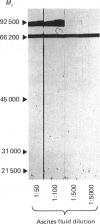Abstract
1. Ten mouse monoclonal antibodies to human complement component C8 were prepared. It was found that six of these antibodies reacted with the alpha-subunit, two with the beta-subunit and two with the gamma-subunit, when assessed by immunoblotting after separation of C8 subunits by SDS/polyacrylamide-gel electrophoresis. 2. Epitope analysis of the ten monoclonal antibodies in a competitive binding assay showed that the six antibodies to the alpha-subunit could be classified in four overlapping epitope groups. The antibodies to the beta- and gamma-subunits bound to a single antigenic site on each, but also cross-reacted with the antigenic sites on the alpha-subunit. 3. Monoclonal anti-C8 immunoaffinity columns were used to purify C8 from fresh human plasma and to prepare C8-depleted serum. Immunoaffinity purified C8 was biologically active when assessed by using haemolysis assays of sheep and rabbit erythrocytes. 4. Salt elution was used to purify either alpha gamma- or beta-subunits when C8 was respectively bound to an anti-beta or anti-alpha immunoaffinity column. The purified subunits reconstituted C8-depleted serum when added together in a haemolysis assay.
Full text
PDF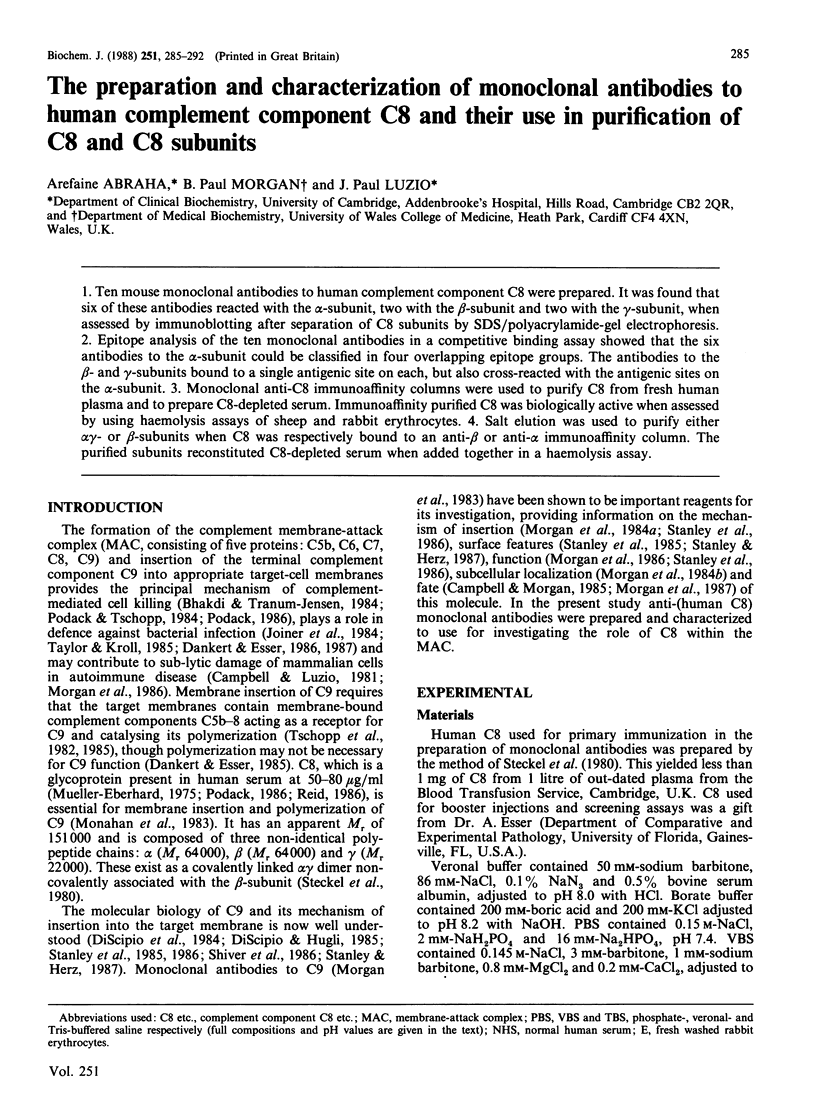
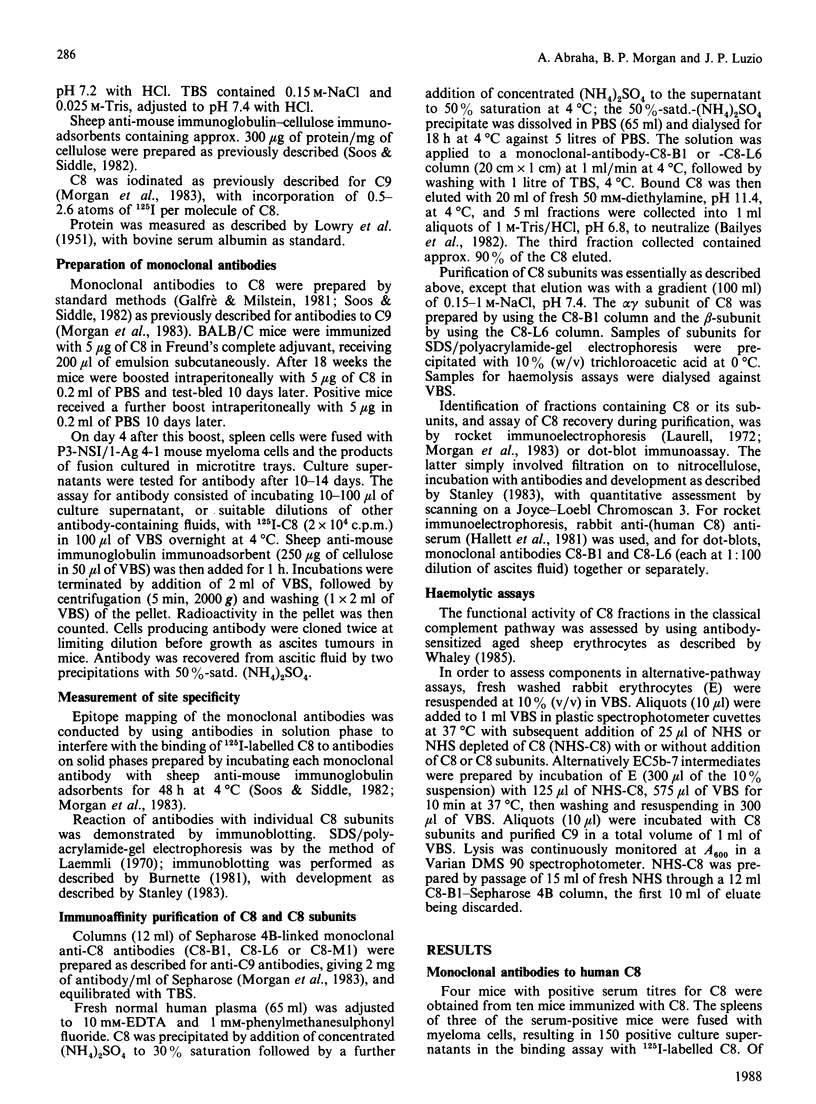
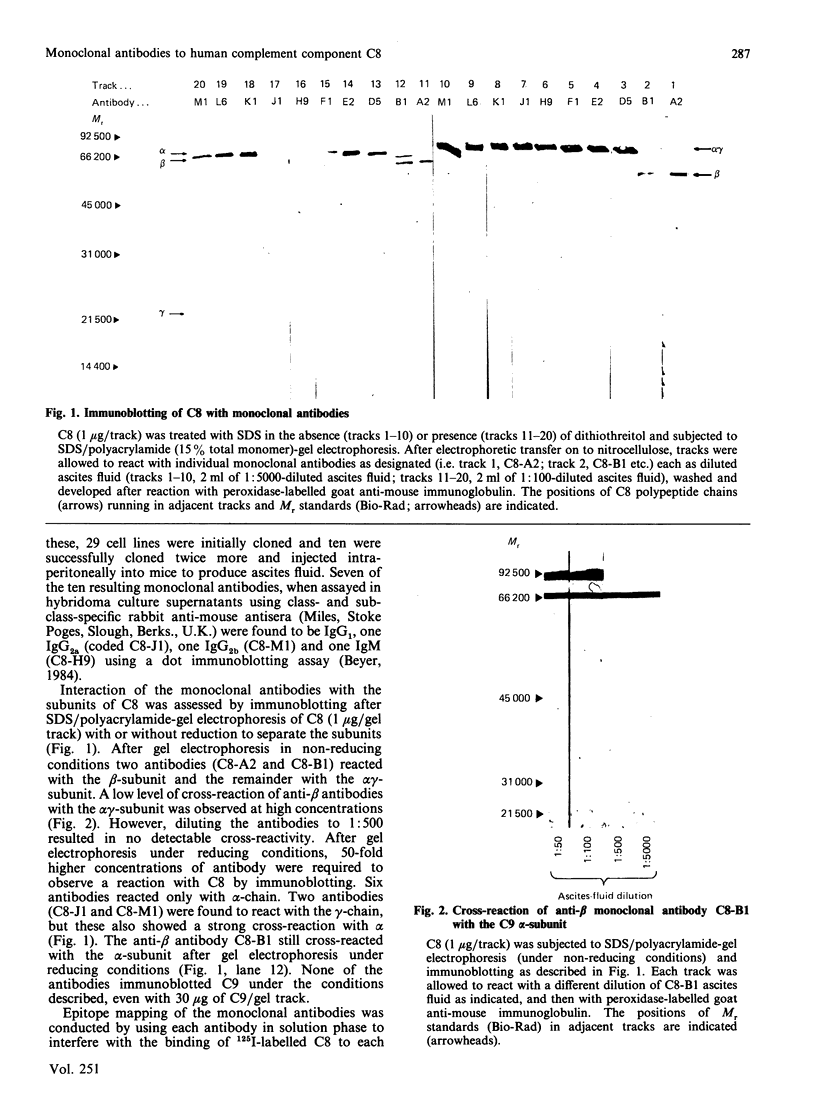
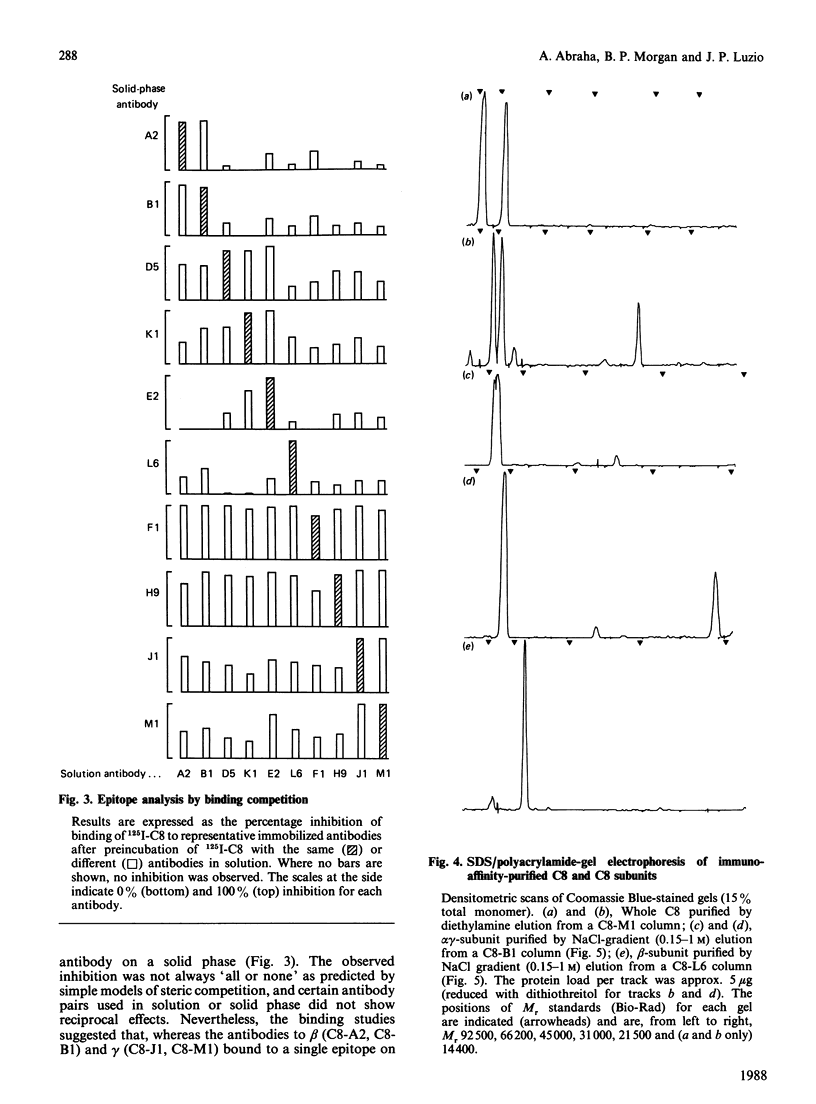
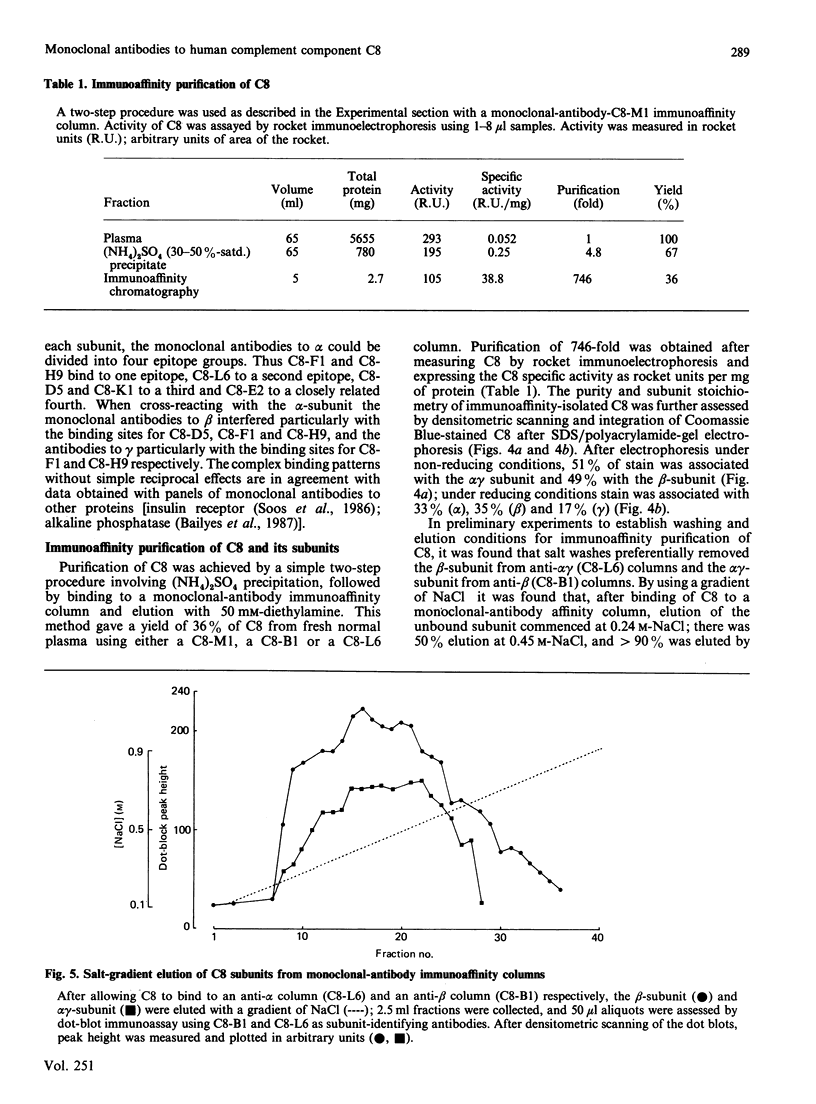
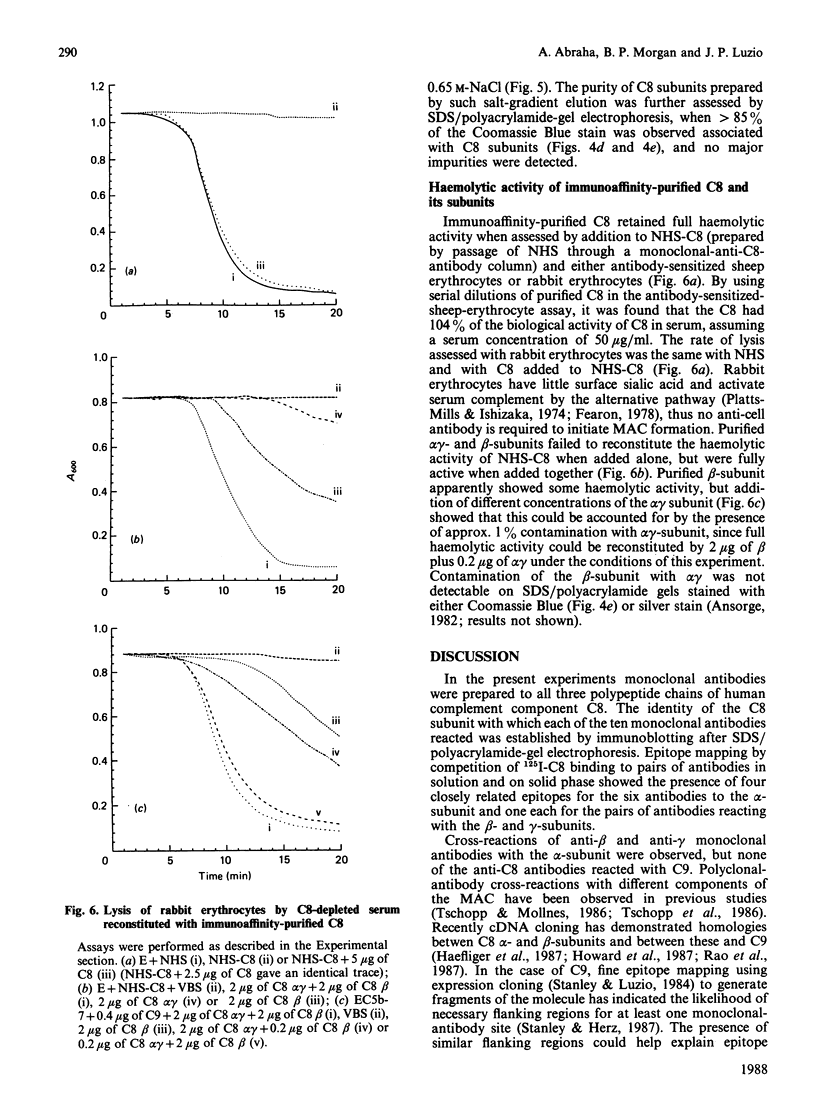
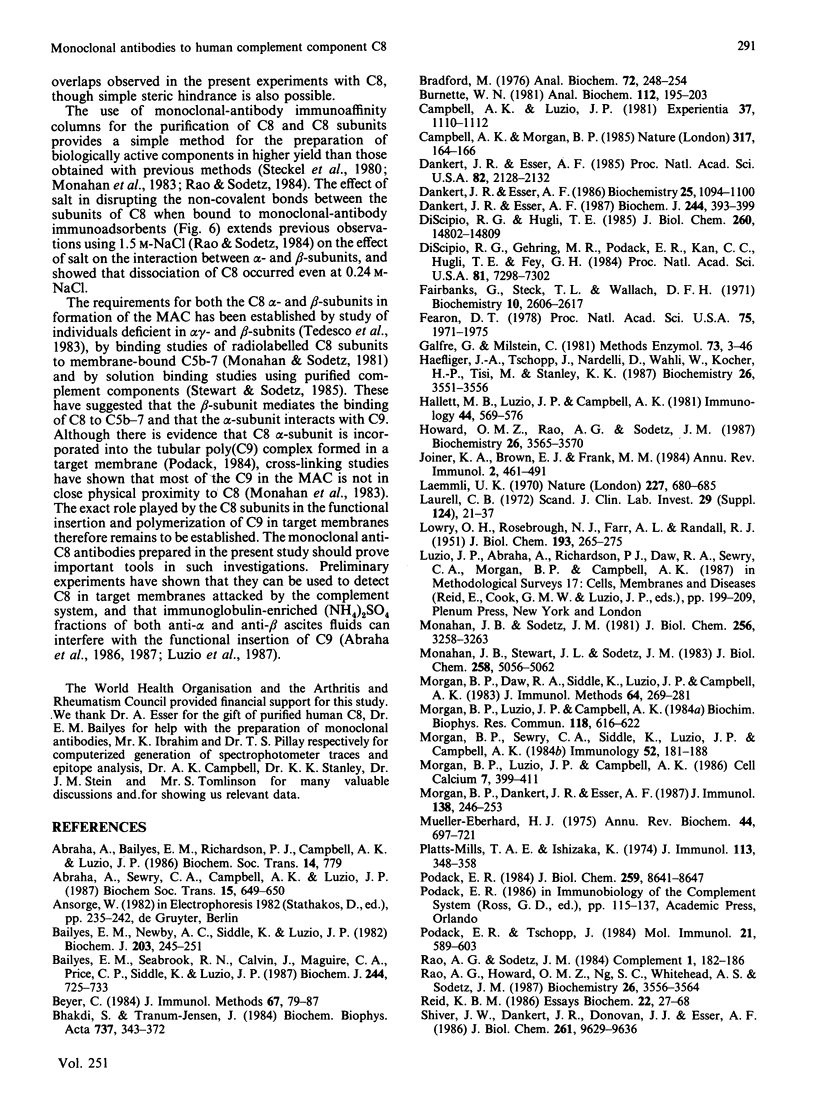
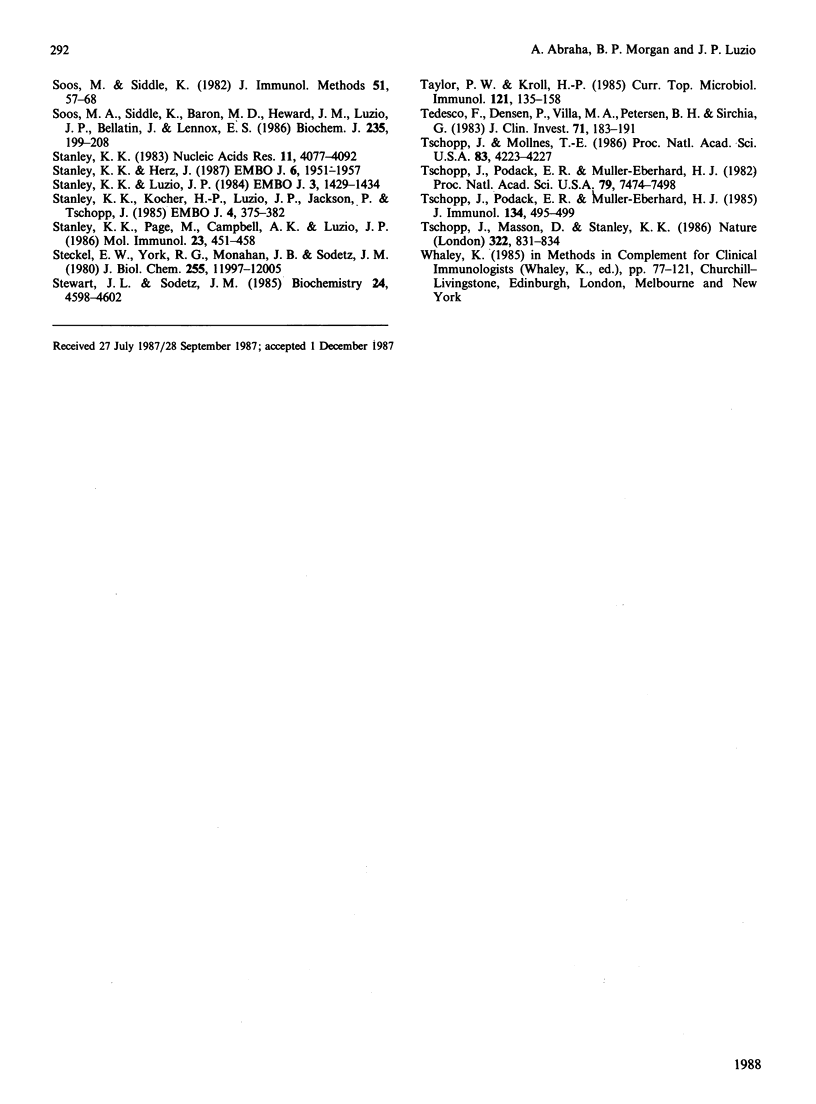
Images in this article
Selected References
These references are in PubMed. This may not be the complete list of references from this article.
- Bailyes E. M., Newby A. C., Siddle K., Luzio J. P. Solubilization and purification of rat liver 5'-nucleotidase by use of a zwitterionic detergent and a monoclonal-antibody immunoadsorbent. Biochem J. 1982 Apr 1;203(1):245–251. doi: 10.1042/bj2030245. [DOI] [PMC free article] [PubMed] [Google Scholar]
- Bailyes E. M., Seabrook R. N., Calvin J., Maguire G. A., Price C. P., Siddle K., Luzio J. P. The preparation of monoclonal antibodies to human bone and liver alkaline phosphatase and their use in immunoaffinity purification and in studying these enzymes when present in serum. Biochem J. 1987 Jun 15;244(3):725–733. doi: 10.1042/bj2440725. [DOI] [PMC free article] [PubMed] [Google Scholar]
- Beyer C. F. A 'dot-immunobinding assay' on nitrocellulose membrane for the determination of the immunoglobulin class of mouse monoclonal antibodies. J Immunol Methods. 1984 Feb 24;67(1):79–87. doi: 10.1016/0022-1759(84)90087-5. [DOI] [PubMed] [Google Scholar]
- Bhakdi S., Tranum-Jensen J. Membrane damage by complement. Biochim Biophys Acta. 1983 Aug 11;737(3-4):343–372. doi: 10.1016/0304-4157(83)90006-0. [DOI] [PubMed] [Google Scholar]
- Bradford M. M. A rapid and sensitive method for the quantitation of microgram quantities of protein utilizing the principle of protein-dye binding. Anal Biochem. 1976 May 7;72:248–254. doi: 10.1016/0003-2697(76)90527-3. [DOI] [PubMed] [Google Scholar]
- Burnette W. N. "Western blotting": electrophoretic transfer of proteins from sodium dodecyl sulfate--polyacrylamide gels to unmodified nitrocellulose and radiographic detection with antibody and radioiodinated protein A. Anal Biochem. 1981 Apr;112(2):195–203. doi: 10.1016/0003-2697(81)90281-5. [DOI] [PubMed] [Google Scholar]
- Campbell A. K., Luzio J. P. Intracellular free calcium as a pathogen in cell damage initiated by the immune system. Experientia. 1981 Oct 15;37(10):1110–1112. doi: 10.1007/BF02085041. [DOI] [PubMed] [Google Scholar]
- Campbell A. K., Morgan B. P. Monoclonal antibodies demonstrate protection of polymorphonuclear leukocytes against complement attack. Nature. 1985 Sep 12;317(6033):164–166. doi: 10.1038/317164a0. [DOI] [PubMed] [Google Scholar]
- Dankert J. R., Esser A. F. Bacterial killing by complement. C9-mediated killing in the absence of C5b-8. Biochem J. 1987 Jun 1;244(2):393–399. doi: 10.1042/bj2440393. [DOI] [PMC free article] [PubMed] [Google Scholar]
- Dankert J. R., Esser A. F. Complement-mediated killing of Escherichia coli: dissipation of membrane potential by a C9-derived peptide. Biochemistry. 1986 Mar 11;25(5):1094–1100. doi: 10.1021/bi00353a023. [DOI] [PubMed] [Google Scholar]
- Dankert J. R., Esser A. F. Proteolytic modification of human complement protein C9: loss of poly(C9) and circular lesion formation without impairment of function. Proc Natl Acad Sci U S A. 1985 Apr;82(7):2128–2132. doi: 10.1073/pnas.82.7.2128. [DOI] [PMC free article] [PubMed] [Google Scholar]
- DiScipio R. G., Gehring M. R., Podack E. R., Kan C. C., Hugli T. E., Fey G. H. Nucleotide sequence of cDNA and derived amino acid sequence of human complement component C9. Proc Natl Acad Sci U S A. 1984 Dec;81(23):7298–7302. doi: 10.1073/pnas.81.23.7298. [DOI] [PMC free article] [PubMed] [Google Scholar]
- DiScipio R. G., Hugli T. E. The architecture of complement component C9 and poly(C9). J Biol Chem. 1985 Nov 25;260(27):14802–14809. [PubMed] [Google Scholar]
- Fairbanks G., Steck T. L., Wallach D. F. Electrophoretic analysis of the major polypeptides of the human erythrocyte membrane. Biochemistry. 1971 Jun 22;10(13):2606–2617. doi: 10.1021/bi00789a030. [DOI] [PubMed] [Google Scholar]
- Fearon D. T. Regulation by membrane sialic acid of beta1H-dependent decay-dissociation of amplification C3 convertase of the alternative complement pathway. Proc Natl Acad Sci U S A. 1978 Apr;75(4):1971–1975. doi: 10.1073/pnas.75.4.1971. [DOI] [PMC free article] [PubMed] [Google Scholar]
- Galfrè G., Milstein C. Preparation of monoclonal antibodies: strategies and procedures. Methods Enzymol. 1981;73(Pt B):3–46. doi: 10.1016/0076-6879(81)73054-4. [DOI] [PubMed] [Google Scholar]
- Haefliger J. A., Tschopp J., Nardelli D., Wahli W., Kocher H. P., Tosi M., Stanley K. K. Complementary DNA cloning of complement C8 beta and its sequence homology to C9. Biochemistry. 1987 Jun 16;26(12):3551–3556. doi: 10.1021/bi00386a045. [DOI] [PubMed] [Google Scholar]
- Hallett M. B., Luzio J. P., Campbell A. K. Stimulation of Ca2+-dependent chemiluminescence in rat polymorphonuclear leucocytes by polystyrene beads and the non-lytic action of complement. Immunology. 1981 Nov;44(3):569–576. [PMC free article] [PubMed] [Google Scholar]
- Howard O. M., Rao A. G., Sodetz J. M. Complementary DNA and derived amino acid sequence of the beta subunit of human complement protein C8: identification of a close structural and ancestral relationship to the alpha subunit and C9. Biochemistry. 1987 Jun 16;26(12):3565–3570. doi: 10.1021/bi00386a047. [DOI] [PubMed] [Google Scholar]
- Joiner K. A., Brown E. J., Frank M. M. Complement and bacteria: chemistry and biology in host defense. Annu Rev Immunol. 1984;2:461–491. doi: 10.1146/annurev.iy.02.040184.002333. [DOI] [PubMed] [Google Scholar]
- LOWRY O. H., ROSEBROUGH N. J., FARR A. L., RANDALL R. J. Protein measurement with the Folin phenol reagent. J Biol Chem. 1951 Nov;193(1):265–275. [PubMed] [Google Scholar]
- Laemmli U. K. Cleavage of structural proteins during the assembly of the head of bacteriophage T4. Nature. 1970 Aug 15;227(5259):680–685. doi: 10.1038/227680a0. [DOI] [PubMed] [Google Scholar]
- Laurell C. B. Electroimmuno assay. Scand J Clin Lab Invest Suppl. 1972;124:21–37. doi: 10.3109/00365517209102748. [DOI] [PubMed] [Google Scholar]
- Monahan J. B., Sodetz J. M. Role of the beta subunit in interaction of the eighth component of human complement with the membrane-bound cytolytic complex. J Biol Chem. 1981 Apr 10;256(7):3258–3262. [PubMed] [Google Scholar]
- Monahan J. B., Stewart J. L., Sodetz J. M. Studies of the association of the eighth and ninth components of human complement within the membrane-bound cytolytic complex. J Biol Chem. 1983 Apr 25;258(8):5056–5062. [PubMed] [Google Scholar]
- Morgan B. P., Dankert J. R., Esser A. F. Recovery of human neutrophils from complement attack: removal of the membrane attack complex by endocytosis and exocytosis. J Immunol. 1987 Jan 1;138(1):246–253. [PubMed] [Google Scholar]
- Morgan B. P., Daw R. A., Siddle K., Luzio J. P., Campbell A. K. Immunoaffinity purification of human complement component C9 using monoclonal antibodies. J Immunol Methods. 1983 Nov 25;64(3):269–281. doi: 10.1016/0022-1759(83)90434-9. [DOI] [PubMed] [Google Scholar]
- Morgan B. P., Luzio J. P., Campbell A. K. Inhibition of complement-induced [14C]sucrose release by intracellular and extracellular monoclonal antibodies to C9: evidence that C9 is a transmembrane protein. Biochem Biophys Res Commun. 1984 Jan 30;118(2):616–622. doi: 10.1016/0006-291x(84)91347-0. [DOI] [PubMed] [Google Scholar]
- Morgan B. P., Luzio J. P., Campbell A. K. Intracellular Ca2+ and cell injury: a paradoxical role of Ca2+ in complement membrane attack. Cell Calcium. 1986 Dec;7(5-6):399–411. doi: 10.1016/0143-4160(86)90042-4. [DOI] [PubMed] [Google Scholar]
- Morgan B. P., Sewry C. A., Siddle K., Luzio J. P., Campbell A. K. Immunolocalization of complement component C9 on necrotic and non-necrotic muscle fibres in myositis using monoclonal antibodies: a primary role of complement in autoimmune cell damage. Immunology. 1984 May;52(1):181–188. [PMC free article] [PubMed] [Google Scholar]
- Müller-Eberhard H. J. Complement. Annu Rev Biochem. 1975;44:697–724. doi: 10.1146/annurev.bi.44.070175.003405. [DOI] [PubMed] [Google Scholar]
- Platts-Mills T. A., Ishizaka K. Activation of the alternate pathway of human complements by rabbit cells. J Immunol. 1974 Jul;113(1):348–358. [PubMed] [Google Scholar]
- Podack E. R. Molecular composition of the tubular structure of the membrane attack complex of complement. J Biol Chem. 1984 Jul 10;259(13):8641–8647. [PubMed] [Google Scholar]
- Podack E. R., Tschopp J. Membrane attack by complement. Mol Immunol. 1984 Jul;21(7):589–603. doi: 10.1016/0161-5890(84)90044-0. [DOI] [PubMed] [Google Scholar]
- Rao A. G., Howard O. M., Ng S. C., Whitehead A. S., Colten H. R., Sodetz J. M. Complementary DNA and derived amino acid sequence of the alpha subunit of human complement protein C8: evidence for the existence of a separate alpha subunit messenger RNA. Biochemistry. 1987 Jun 16;26(12):3556–3564. doi: 10.1021/bi00386a046. [DOI] [PubMed] [Google Scholar]
- Rao A. G., Sodetz J. M. Purification of functional subunits of the eighth component of human complement (C8) under nondenaturing conditions. Complement. 1984;1(4):182–186. doi: 10.1159/000467835. [DOI] [PubMed] [Google Scholar]
- Reid K. B. Activation and control of the complement system. Essays Biochem. 1986;22:27–68. [PubMed] [Google Scholar]
- Shiver J. W., Dankert J. R., Donovan J. J., Esser A. F. The ninth component of human complement (C9). Functional activity of the b fragment. J Biol Chem. 1986 Jul 25;261(21):9629–9636. [PubMed] [Google Scholar]
- Soos M. A., Siddle K., Baron M. D., Heward J. M., Luzio J. P., Bellatin J., Lennox E. S. Monoclonal antibodies reacting with multiple epitopes on the human insulin receptor. Biochem J. 1986 Apr 1;235(1):199–208. doi: 10.1042/bj2350199. [DOI] [PMC free article] [PubMed] [Google Scholar]
- Soos M., Siddle K. Characterization of monoclonal antibodies directed against human thyroid stimulating hormone. J Immunol Methods. 1982;51(1):57–68. doi: 10.1016/0022-1759(82)90382-9. [DOI] [PubMed] [Google Scholar]
- Stanley K. K., Herz J. Topological mapping of complement component C9 by recombinant DNA techniques suggests a novel mechanism for its insertion into target membranes. EMBO J. 1987 Jul;6(7):1951–1957. doi: 10.1002/j.1460-2075.1987.tb02457.x. [DOI] [PMC free article] [PubMed] [Google Scholar]
- Stanley K. K., Kocher H. P., Luzio J. P., Jackson P., Tschopp J. The sequence and topology of human complement component C9. EMBO J. 1985 Feb;4(2):375–382. doi: 10.1002/j.1460-2075.1985.tb03639.x. [DOI] [PMC free article] [PubMed] [Google Scholar]
- Stanley K. K., Luzio J. P. Construction of a new family of high efficiency bacterial expression vectors: identification of cDNA clones coding for human liver proteins. EMBO J. 1984 Jun;3(6):1429–1434. doi: 10.1002/j.1460-2075.1984.tb01988.x. [DOI] [PMC free article] [PubMed] [Google Scholar]
- Stanley K. K., Page M., Campbell A. K., Luzio J. P. A mechanism for the insertion of complement component C9 into target membranes. Mol Immunol. 1986 May;23(5):451–458. doi: 10.1016/0161-5890(86)90108-2. [DOI] [PubMed] [Google Scholar]
- Stanley K. K. Solubilization and immune-detection of beta-galactosidase hybrid proteins carrying foreign antigenic determinants. Nucleic Acids Res. 1983 Jun 25;11(12):4077–4092. doi: 10.1093/nar/11.12.4077. [DOI] [PMC free article] [PubMed] [Google Scholar]
- Steckel E. W., York R. G., Monahan J. B., Sodetz J. M. The eighth component of human complement. Purification and physicochemical characterization of its unusual subunit structure. J Biol Chem. 1980 Dec 25;255(24):11997–12005. [PubMed] [Google Scholar]
- Stewart J. L., Sodetz J. M. Analysis of the specific association of the eighth and ninth components of human complement: identification of a direct role for the alpha subunit of C8. Biochemistry. 1985 Aug 13;24(17):4598–4602. doi: 10.1021/bi00338a018. [DOI] [PubMed] [Google Scholar]
- Taylor P. W., Kroll H. P. Effect of lethal doses of complement on the functional integrity of target enterobacteria. Curr Top Microbiol Immunol. 1985;121:135–158. doi: 10.1007/978-3-642-45604-6_7. [DOI] [PubMed] [Google Scholar]
- Tedesco F., Densen P., Villa M. A., Petersen B. H., Sirchia G. Two types of dysfunctional eighth component of complement (C8) molecules in C8 deficiency in man. Reconstitution of normal C8 from the mixture of two abnormal C8 molecules. J Clin Invest. 1983 Feb;71(2):183–191. doi: 10.1172/JCI110758. [DOI] [PMC free article] [PubMed] [Google Scholar]
- Tschopp J., Masson D., Stanley K. K. Structural/functional similarity between proteins involved in complement- and cytotoxic T-lymphocyte-mediated cytolysis. 1986 Aug 28-Sep 3Nature. 322(6082):831–834. doi: 10.1038/322831a0. [DOI] [PubMed] [Google Scholar]
- Tschopp J., Mollnes T. E. Antigenic crossreactivity of the alpha subunit of complement component C8 with the cysteine-rich domain shared by complement component C9 and low density lipoprotein receptor. Proc Natl Acad Sci U S A. 1986 Jun;83(12):4223–4227. doi: 10.1073/pnas.83.12.4223. [DOI] [PMC free article] [PubMed] [Google Scholar]
- Tschopp J., Podack E. R., Müller-Eberhard H. J. The membrane attack complex of complement: C5b-8 complex as accelerator of C9 polymerization. J Immunol. 1985 Jan;134(1):495–499. [PubMed] [Google Scholar]
- Tschopp J., Podack E. R., Müller-Eberhard H. J. Ultrastructure of the membrane attack complex of complement: detection of the tetramolecular C9-polymerizing complex C5b-8. Proc Natl Acad Sci U S A. 1982 Dec;79(23):7474–7478. doi: 10.1073/pnas.79.23.7474. [DOI] [PMC free article] [PubMed] [Google Scholar]




